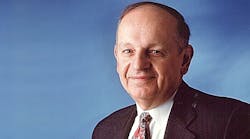1993 Tech Leader: Dr. George H. Heilmeier, President and CEO, Bellcore
If Dr. George H. Heilmeier were a general and wore one medal on his chest for each of his patents, for each of his national and international awards for technical achievement, and for his vision of a national information superhighway, he would walk with a list.
The president and CEO of Bellcore, the $1.1 billion research organization for the seven Baby Bells, based in Livingston, N.J., has 15 patents in the areas of electro-optic effects in molecular and liquid crystals. He also has won 19 national and international awards for technical accomplishments in business and government, including the National Medal of Science awarded by former President Bush.
During his career in the telecommunications, defense, and computer industries, he has initiated programs crucial to national security, including the Stealth Bomber and "Star Wars." During his early career at RCA Laboratories in the 1960s, his innovative work in liquid-crystal research led directly to the development of liquid-crystal displays, which are an essential component of today's consumer-electronics products, instrumentations, and computer displays worldwide.
Today Dr. Heilmeier is a major force in coordinating the development of a national information infrastructure that would bring interactive media into the home by linking telephones, computers, and television to produce video, sound, and data.
The signing this year by 13 telecommunications CEOs of a landmark public-policy position statement supporting the Clinton-Gore initiative, "Technology for America's Economic Growth, A New Direction to Build Economic Strength," came as a result of his vision, stamina, and unwavering belief in the competitive advantages of an information superhighway in the U.S.
Drafted by Dr. Heilmeier and signed at his suggestion by the CEOs of AT&T, GTE, MCI, Sprint, and Bellcore's seven owners, the statement helped catapult the building of his vision of a national information network to the top of the U.S. political and economic agenda. (The proposed acquisition of Tele-Communications Inc., the Denver-based cable giant, by Bell Atlantic, the Philadelphia-based regional phone company, announced in October is perhaps only the first thunderbolt heralding the coming of Dr. Heilmeier's vision for the 21st century's version of the Interstate Highway System.)
On the "short list" to succeed IBM CEO John Akers earlier this year, Dr. Heilmeier treats research as religion. The former chief technical officer of Texas instruments Inc. before he arrived at Bellcore in 1991 applies what he affectionately calls "Heilmeier's catechism" to the management problems of technology transfer, innovation, and invention.
Developed more than 17 years ago, his catechism aids management decision-making by asking nine Rene Descartes-like basic questions: What are you trying to do? How is it done now, and what are the limitations of the current practice? What's new in your approach, and why do you think it will be successful? If you're successful, what difference will it make? How do our customers get paid? What are the risks? How much will it cost? How long will it take? What are the mid-term and final exams?
Sitting in his comfortable office, Dr. Heilmeier laughs when asked to apply his catechism to his current labor of love -- the creation of a national information infrastructure.
"I think the bottom line is to bring information-age capabilities to everyone," he replies, "capabilities that enable people and their machines to access information anywhere, anytime, in any medium or combination of media in a cost-effective and secure manner."
Today people go to information rather than the information coming to them. "What's new is a paradigm shift, using telecommunications to essentially bring information to people," says the visionary."we think it'll be successful because microelectronics is already making distributable intelligence ~free' and fiber optics is making the transport of information ~free."'
Such an infrastructure would bring Mayo Clinic medical minds to rural communities, create virtual universities, change use patterns of fossil fuels, and could reverse advertising and purchasing processes.
The risks? "I don't see any major new inventions that need to be made," says Dr. Heilmeier. "But I think an outdated regulatory environment is a barrier to the expedited creation of an information infrastructure.
"Today, regulations prevent the Bell regional operating companies from making a reasonable return on their investment in a broadband fiber-optic network. We're not talking about putting the old Bell System back together. But we can't operate in the information age with all of the restrictions, rules, regulations, and constraints that were characteristic of a monopoly age."
Dr, Heilmeier thinks that existing digital telecommunications technology can be used in creative ways to whet the appetites of consumers and business for the national information highway.
"In the next five years we can move in the direction of an information superhighway by using digital networks" to simultaneously transmit voice, data, video, and graphics over a single copper telephone line, he says. "But we won't have fiber-optic cable into all the homes in the U.S. until well into the second decade of the 21st century." Fiber-optic cable is a crucial ingredient in true interactive media systems because it can carry more information and produce high-definition TV pictures.
"For now we must begin to make the vision real and demonstrate information-age capabilities as soon as possible using the existing network. We must make it user-friendly and prepare the ground work for increasing peoples' interest in more advanced capabilities."




